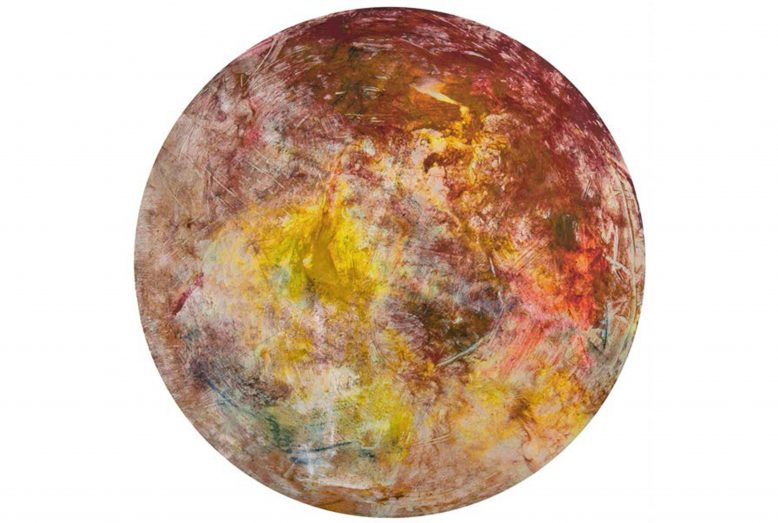Beverly Barkat. From Venice to Rome
13 July 2018

Evocative Surfaces take up permanent residence at the Museo di Palazzo Grimani in Venice
After the Tribes at Museo Boncompagni Ludovisi in Rome
Curated by Dr. Giorgia Calò
October 11 – December 31, 2018
Opening, October 10, 6.30-9.30 pm
More than a year has passed since Evocative Surfaces, a large exhibition at theMuseo di Palazzo Grimani during the most recent Venice Art Biennale, which firmly established Beverly Barkat as a presence on the contemporary arts scene. Three of the works then on display, large-scale banner paintings on PVC hanging from the ceiling of the magnificent Venetian Renaissance palazzo, have now become a permanent installation at the museum and part of its collections. By adding her works to the museum’s highly noteworthy decorations and frescoes, the Israeli artist makes a lasting contribution to the artistic heritage of Venice.
In response to an invitation from the Polo Museale del Lazio and the Office for Culture of the Embassy of Israel in Italy, Beverly’s deep bond with Italy will soon find new expression in After the Tribes in Rome, a site specific installation curated by Dr.Giorgia Calò with the support of the Nomas Foundation. The exhibition will open on October 10 in the suggestive spaces of the Museo Boncompagni Ludovisi.
As in her earlier exhibition at Palazzo Grimani, the starting point for the artist are the materials themselves. She layers them into a work that is self-complete while also engaging its surroundings in a harmonious dialogue. The new exhibition is an evocative, mutable journey from deep roots in the Old Testament and the origins of the Jewish people to the contemporary era.
After the Tribes is a powerful installation conceived specifically for the Museo Boncompagni Ludovisi. It retraces a history that reaches back across the millennia and merges into the present, creating a subtle dialogue between the visitor experience, Barkat’s work, and the museum space.
After the Tribes is a bold four-meter tower planted firmly on the ground yet rising to achieve transcendence. It will be placed in the splendid Salone delle Vedute with its murals of the allées and gardens of Villa Ludovisia. The primary geometrical forms decorating both the interiors and the façade of the twentieth century urban villa find an echo in Barkat’s work, creating a dialectic between the venerable and the contemporary. The metal framework is cadenced by twelve squares that represent the twelve tribes of Israel and the origins of the Jewish people.
Each of the twelve tribes was distinguished by a specific color scheme that was represented on their banners and by the gemstones decorating the breastplates of priests. These colors are replicated by the artist via an elaborate process of seeking, gathering, cataloguing, and reusing materials from her homeland. Shells, stratified stones, semi-precious stones, sand, rock, and clay from caves, the desert, the sea, and the mountains of Israel are transformed into the essential and conceptual colors of Barkat’s installation.
The twelve circular paintings can be viewed from both sides. The artist applied her materials to one side, which is thus rough and textured, while the other side offers a view through the transparent PVC support, revealing the layers of color, the painter’s marks, and their real consistency under a smooth, glossy film.
The artist’s work concentrates on color and material to produce a complex universe of symbols and citations, explains the curator Dr. Giorgia Calò, which she accesses via her unmistakable painterly gesture, drawing inspiration as much from classical tradition as from modern art movements such as Abstract Expressionism. We could define her work as being alchemical, in that she transmutes substances, going beyond the physical to imbue them with mystical and spiritual qualities.
Material, cartographic, cabalistic, and symbolic references transform After the Tribes into a journey across thousands of years, reflecting on the origins of peoples transcending all political contingency as it returns to the contemporary.
Beverly Barkat, biographical notes
Beverly Barkat was born in Johannesburg, South Africa in 1966, moving to Israel with her family in 1976. The daughter of two artists, she grew up immersed in art. After her degree in Fine Arts from the Bezalel Academy of Arts and Design in Jerusalem, she began working with clay, metal, and glass, but later shifted to drawing and oil painting after an inspiring master class led by Israel Hershberg at the Jerusalem Studio School.
Motivated by an unflagging interest in experimenting with new materials, as well as by the desire to discover the potential energy of architectural spaces, Barkat was actively involved in designing or remodeling environments, including common areas and private homes. Committed to improving the scholastic experience, she has also designed a number of elementary school libraries.
In 2009, Barkat opened her own studio in Jerusalem, where she continues to develop her own unique artistic idiom. Her media include drawing and painting on paper, self-built canvases, and PVC on which she uses various implements, exploiting the techniques and skills she has learned in the various disciplines she has explored.
Press Office
Lightbox
Elena Pardini | +39 348 3399463 | elena@lightboxgroup.net | www.ligthboxgroup.net